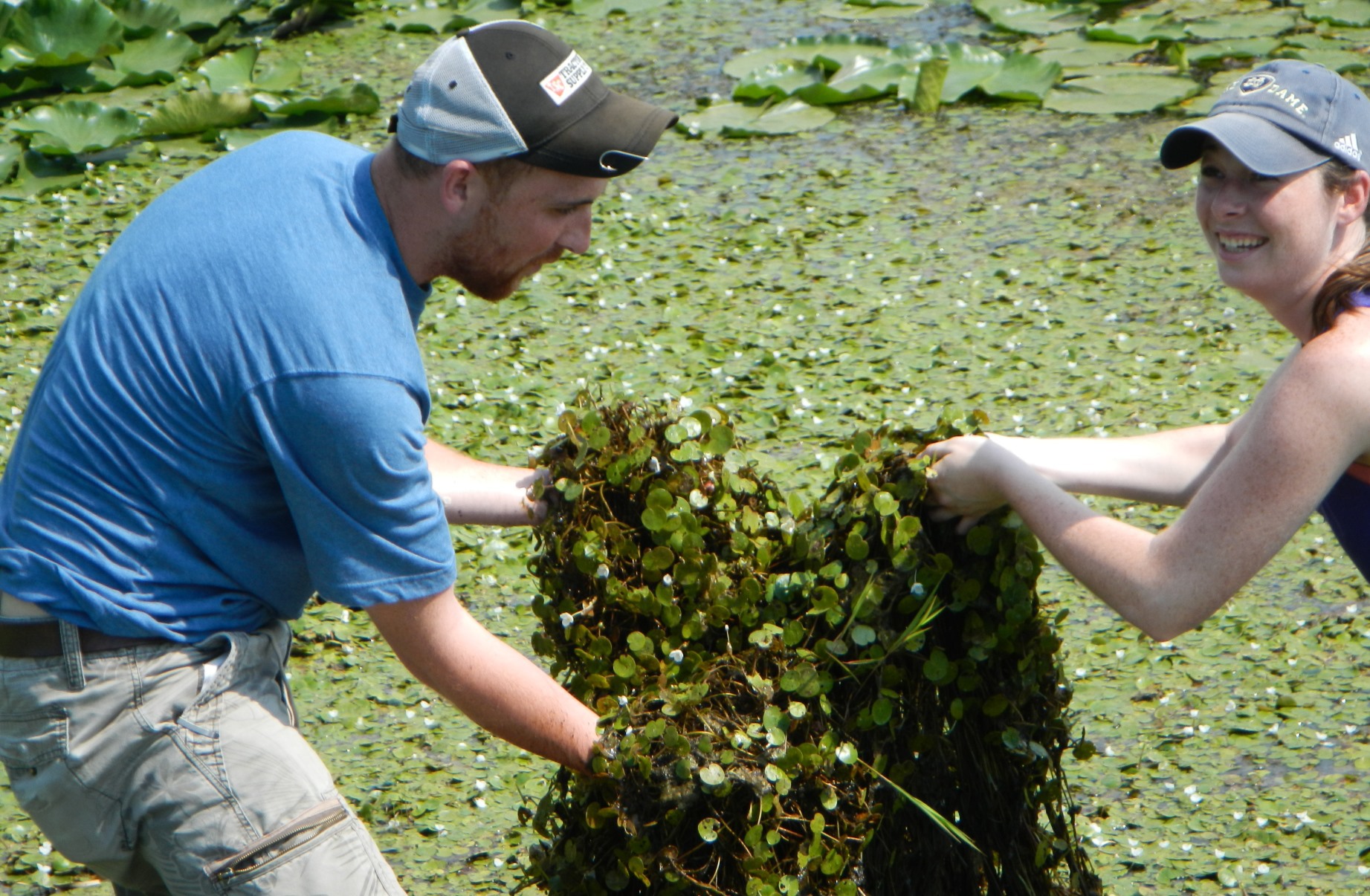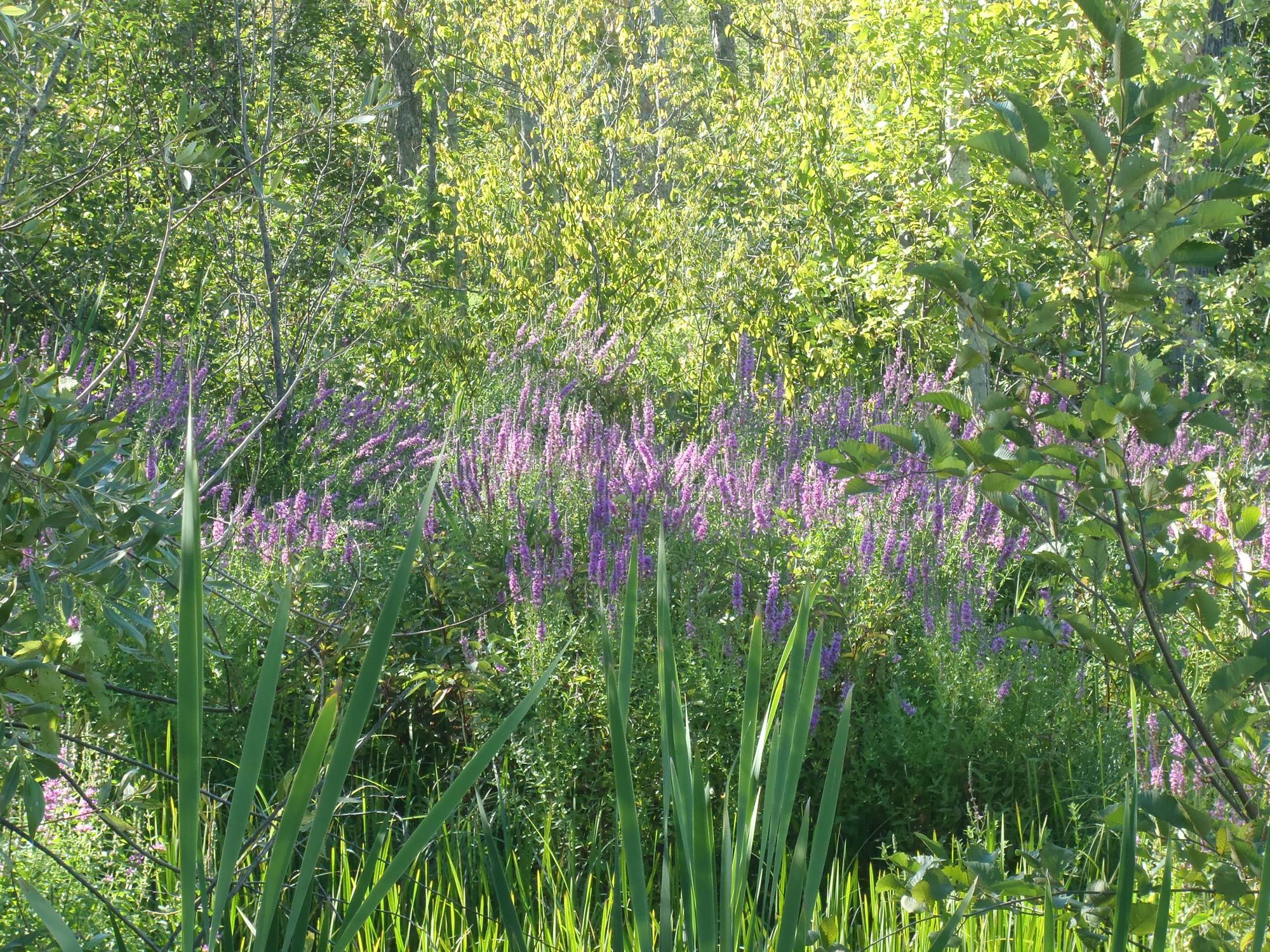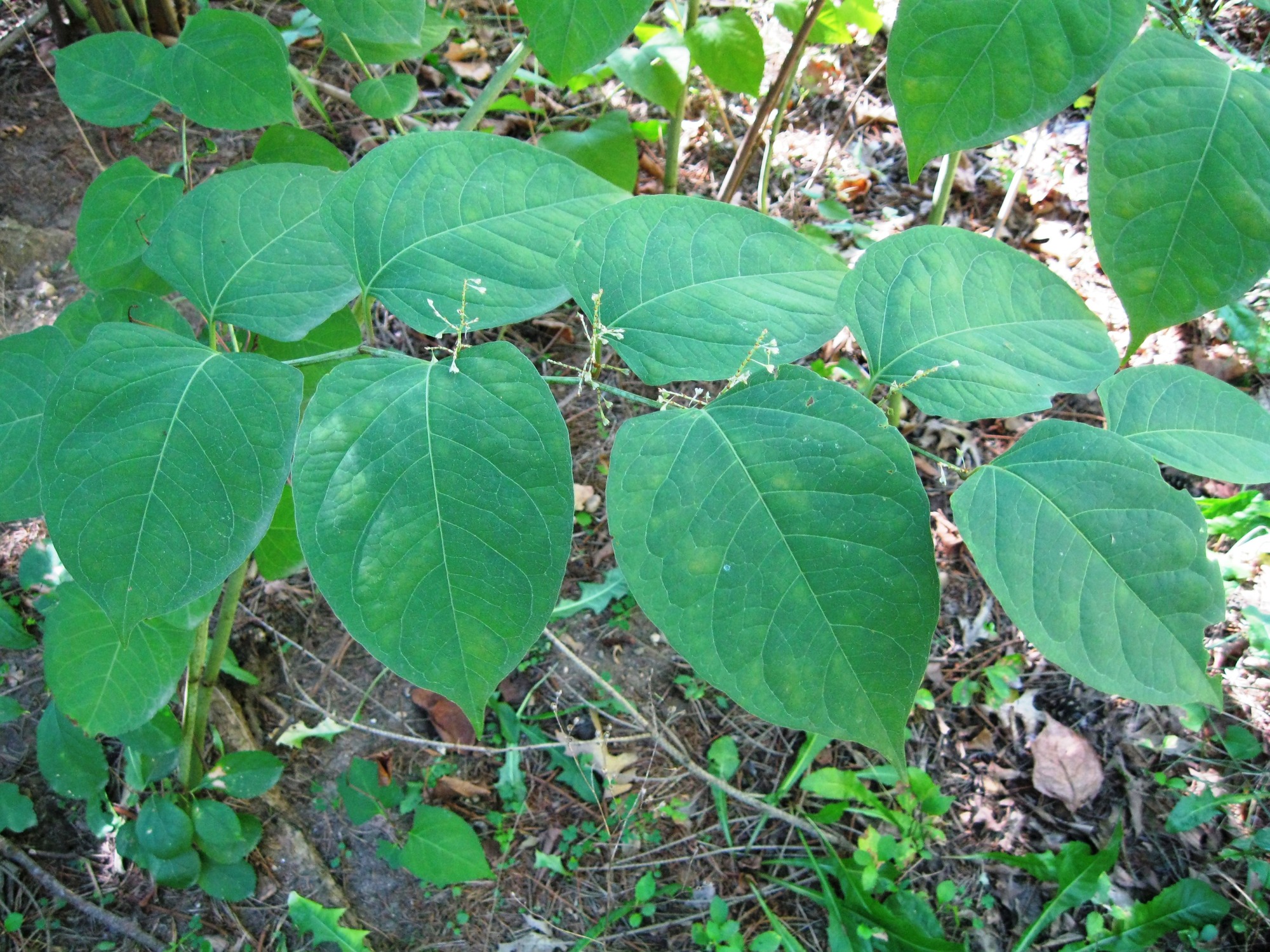Know what to grow and where – keeping a spotlight on invasive plants
One of the top priorities for the Michigan Department of Natural Resources is raising awareness about invasive species, including plants.
As gardening season swings into high-gear, the DNR wants growers to think about invasive species and their potential impacts and connections, especially when it comes to selecting plants for spring gardening.
“We want gardeners to make sure that what they’re planting is the right plant for the right place, so that they don’t inadvertently introduce or spread vegetation that can become invasive in the wrong setting,” said Ryan Wheeler, a terrestrial invasive species biologist with the DNR.
Michigan's Invasive Species Program is cooperatively managed by the Michigan departments of Natural Resources, Agriculture and Rural Development, and Environmental Quality.
 Invasive species Invasive species
An invasive species is one that is not native and whose introduction causes harm, or is likely to cause harm to Michigan's economy, environment or human health.
Many non-native species in Michigan, including fruits, vegetables, field crops, ornamentals, livestock and domestic animals, are important to our economy and lifestyle. Most non-native species are not harmful in the appropriate setting and may provide economic and social benefits.
Invasive species cause harm when they out-compete native species by reproducing and spreading rapidly in areas where they have no natural predators and change the balance of the ecosystems we rely on.
Means
Nearly all invasive species find their way here with the help of humans. Modern means of transportation bring goods, services, people and invasive species to all reaches of the globe.
Ballast water from ships is one pathway for introducing invasive organisms to Great Lakes waters. Some non-native pets and plants that escape into the wild adapt and thrive in local conditions. Insects arriving from abroad in wood packing materials and wood products have caused irreparable damage to native trees and forests.
Some invasive species were brought to the U.S. intentionally as game or food species.
What makes many invasive species so successful is their ability to colonize new areas very rapidly.
For plants, this can mean having seeds that are eaten and distributed by birds, such as autumn olive, seeds that easily disperse or catch on clothing or fur, or plant parts that can reproduce whole plants from cut or broken pieces, like Eurasian watermilfoil.
Gypsy moth egg masses and emerald ash borer larvae have been transported to many sites in Michigan on firewood. Microscopic zebra mussel larvae and many invasive aquatic plants have hitchhiked from one lake to another on watercraft and trailers.
Garlic mustard has spread along many roadsides and forest trails with the help of cars, mowers, all-terrain vehicles and hikers. In fact, for many invasive species, hitchhiking with humans is a common mode of transportation.
Watch list
Michigan has a watch list of invasive species.
Those invasive species on the list have been identified as being an immediate and significant threat to Michigan's natural resources. These species either have never been confirmed in the wild in Michigan or they have a limited known distribution.
Gardeners should become familiar with this list when shopping for landscape plants.
“Some watch list species are legal for sale but need to be contained in gardens,” said Joanne Foreman, DNR invasive species communications coordinator. “These species should be reported if found outside of cultivation.”
Some invasive species legally are designated by the state of Michigan as either “prohibited” or “restricted.” If a species is prohibited or restricted, it is unlawful to possess, introduce, import, sell or offer that species for sale as a live organism, except under certain circumstances.
The term “prohibited” is used for species that are not widely distributed in the state. Often, management or control techniques for prohibited species are not available. “Restricted” is applied to species that are established in the state. Management and control practices are usually available for these species.
Michigan’s Natural Resources Environmental Protection Act (Part 413 of Act 451) established the list of prohibited and restricted species, which is regularly amended by Invasive Species Orders.
“Plants on the state’s prohibited or restricted list can’t be legally sold in Michigan,” Foreman said. “The Michigan Department of Agriculture and Rural Development regularly conducts inspections of plant dealers and growers throughout the state and maintains communication with the nursery industry to assure dealers are aware of listed plants.”
Other methods
However, there are other ways of obtaining plants beyond buying them at the garden center, and these can lead to the unintended spread of invasive plants.
Digging up plants along the roadside to transplant in gardens is one method, but it is not recommended.
“Often, people don’t realize that digging up and transporting plants from rights-of-way or other public land requires a permit,” said Susan Tangora, section manager for the DNR’s forest health and cooperative programs. “And those pretty flowers may turn into an uncontrollable problem in your garden or landscape.”
 Purple loosestrife is a very prolific invasive species that grows in wetland areas and is often sought after by flower enthusiasts. Purple loosestrife is a very prolific invasive species that grows in wetland areas and is often sought after by flower enthusiasts.
“You drive the road and you see it and it’s very pretty,” Foreman said. “I remember going to a 4-H event and one of the youngsters had some purple loosestrife in a wildflower arrangement. It’s very widespread.”
In the wild, loosestrife will dominate a plant community.
“If you see it on the edge of a wetland, in a year that whole wetland could be purple loosestrife,” Tangora said. “It not only takes the place of plants that are benal to wildlife, but it becomes the lone representative species.”
Many gardeners enjoy sharing or trading plants. This is another means to proliferate invasive species.
Some plants, such as Japanese knotweed, fall into this category.
Known by a variety of names – fleece flower and Michigan bamboo among them – Japanese knotweed is a fast-growing shrub that became popular as a buffer or border planting along roadsides and between properties.
It is now a prohibited species in Michigan and at least five other states and is considered one of the 100 worst invasive species in the world.
“It grows in a clump of stalks that are jointed and resemble bamboo,” Wheeler said. “It can grow quite tall – more than 10 feet in a single season and it spreads quickly – which is why I imagine people shared the plant.
Wheeler said there are several problems with Japanese knotweed.
“For one thing, knotweed will grow through sidewalks and building foundations, causing damage. It can also grow from fragments, so if you mow it down, the pieces that the mower throws could potentially grow new plants,” Wheeler said. “But it can also spread by rhizomes – thick, underground plant stems with growing roots or shoots – so you may think you’ve killed the main stalk and then it can pop right back up nearby. It’s very hard to kill.” so you may think you’ve killed the main stalk and then it can pop right back up nearby. It’s very hard to kill.”
Shopping
Foreman said gardeners who shop on the Internet or by catalog should familiarize themselves with Michigan’s invasive plants before they buy.
“Out-of-state nurseries may not be familiar with Michigan’s law,” Foreman said. “Their stock may include plants that are legal where they’re headquartered, but not here.”
Farm markets, festivals and roadside stands are other potential sources of invasive plants. Plant nurseries and growers in Michigan are required to be licensed.
“Before you purchase, check to see if the vendor is licensed, so you can be assured of quality merchandise,” Foreman said.
More water plants
One particularly problematic source of invasive plants is aquatic vegetation.
“That’s one of our biggest concerns,” Wheeler said. “There are several species of popular pond plants that are legal to sell and appropriate in controlled settings. The problem is that when disposed of improperly, these plants are showing up in the wild where they cause a lot of harm.”
Water hyacinth is one example.
“It floats in a mat with big purple flowers and people have utilized it for ponds for years, but it’s highly invasive outside cultivation,” Tangora said. “Based on where we’re pulling it out of rivers and lakes, we can assume it has escaped from those ponds.”
The species is on the watch list, but not prohibited nor restricted.
 Parrot feather is another for instance. Parrot feather is another for instance.
This plant looks a lot like a feather coming out of the water, making it a popular aquarium species. The first discovery of this plant in southeast Michigan showed how quickly this plant can take over a pond.
“This plant probably came from a home owner dumping their aquarium into the pond,” Wheeler said. “Three years later, and half the pond is covered in parrot feather so thick you could walk on it.”
Control efforts by the DNR and partners over the last couple of years at this site have been successful in eradicating this plant.
Hitchhikers
Moving plants around adds the potential to move invasive animals too. All plants should be inspected for inadvertent hitchhikers.
“Whenever you buy or bring home plants, you should check the container and plant roots to make sure you don’t have snails or worms in the soil,” Foreman said. “There are a lot of invasive snails on the prohibited and restricted species list.”
If you do find live creatures in your plants, remove them and dispose of them properly.
“Seal them in a bag and put it into the trash so it gets sent to a landfill,” Foreman said. “Don’t compost them. Don’t flush them. Those are just additional unintended methods of spreading them.”
Responsibility
Many invasive plants have become so well established that they may always be with us. In those cases, it’s a matter of trying to keep them contained, until more efficient and long-term means of control are developed.
However, preventing additional invasive species from becoming established is everyone’s job. Learn about Michigan’s invasive plants and which varieties may be restricted or prohibited.
“This is one sure way growers can help in the battle against invasive plant species,” Foreman said. “A gardener can cultivate a lot of goodwill just by discovering a little bit of useful information and passing it on to others.”
In the end, these seemingly small efforts can provide significant benefits to Michigan’s natural resources, including wildlife, water resources and our vibrant native plant and forest communities.
Check out the invasive species watch list.
Find out more about invasive plants. Visit the new invasive species website.
Catch upcoming stories by subscribing to free, weekly “Showcasing the DNR” articles. Previous articles are available at www.michigan.gov/dnr-stories.
/Note to editors: Contact: Joanne Foreman, 517-284-5814 or Susan Tangora, 517-420-0128. Accompanying photos are available below for download and media use. Suggested captions follow. Credit: Michigan Department of Natural Resources./
Loosestrife: Purple loosestrife is an attractive wetland plant, but it is also an invasive species that spreads quickly and can dominate native species.
Knotweed: Leaves of the Japanese knotweed plant are shown. This invasive shrub species became popular as a buffer or border planting along roadsides and between properties, but is now prohibited in several states, including Michigan./
The Michigan Department of Natural Resources is committed to the conservation, protection, management, use and enjoyment of the state’s natural and cultural resources for current and future generations. For more information, go to www.michigan.gov/dnr.
|